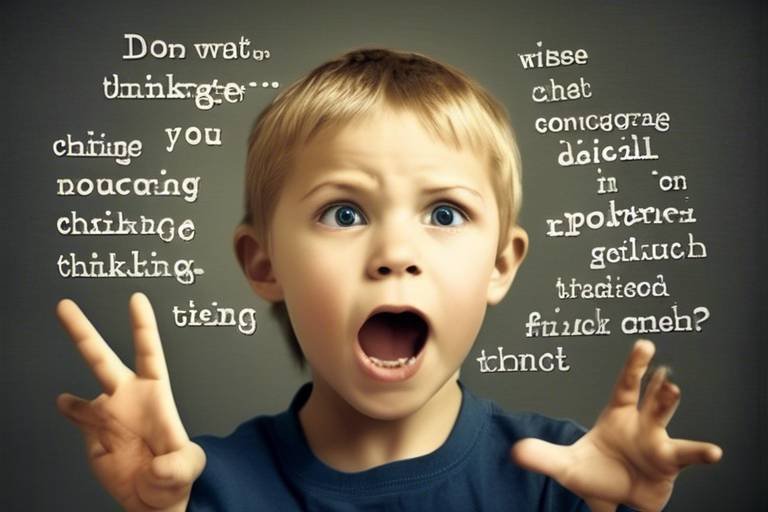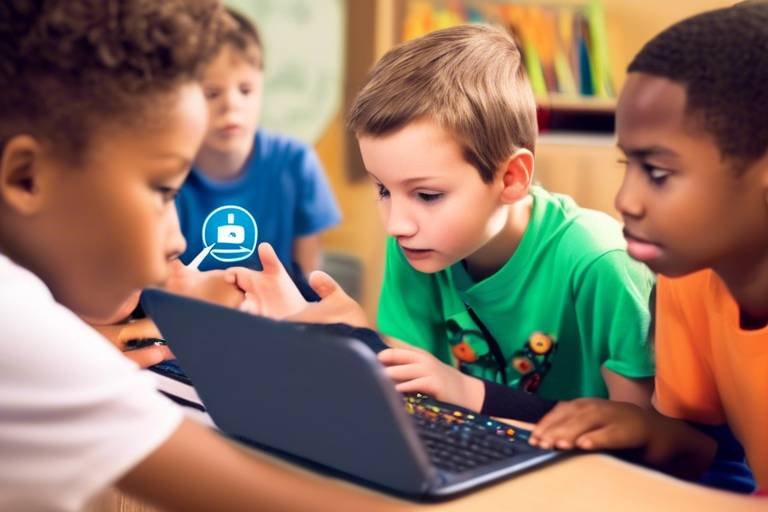Preparing Your Kids for the Future Workforce
In today's fast-paced world, preparing our children for the future workforce is more crucial than ever. With the job market evolving at an unprecedented rate, it's essential to equip kids with the right skills and knowledge to thrive in a competitive environment filled with both opportunities and challenges. So, what does this preparation entail? It goes beyond academic excellence; it involves nurturing a range of skills that will enable children to adapt and excel in various career paths. From developing soft skills to encouraging a passion for STEM education, we must lay a solid foundation for their future.
Imagine a world where your child not only understands the basics of math and science but is also adept at communicating their ideas effectively and working collaboratively with others. This is the future we can help create by fostering essential skills early on. As parents and educators, we have the power to influence their growth and development significantly. By focusing on both hard and soft skills, we can ensure that our kids are not just job-ready but are also equipped to navigate the complexities of the modern workforce.
As we dive deeper into this topic, we will explore various strategies to support our children in their journey toward becoming well-rounded individuals. We’ll look at the importance of soft skills, the growing relevance of STEM education, and how fostering a growth mindset can empower them to tackle challenges head-on. Each of these elements plays a vital role in shaping their future, and understanding how to integrate them into their daily lives can make all the difference.
So, are you ready to embark on this journey with your children? Together, we can unlock their potential and prepare them for a world filled with possibilities. Let's explore the essential skills and strategies that will not only help them succeed but also inspire them to pursue their passions and dreams.
Soft skills like communication, teamwork, and adaptability are crucial for success in any career. This section discusses how to cultivate these skills in children from an early age.
Science, Technology, Engineering, and Mathematics (STEM) fields are rapidly growing. Here, we explore methods to inspire kids to engage with STEM subjects and pursue related careers.
Engaging children in hands-on activities fosters a deeper understanding of STEM concepts. This subheading highlights various practical projects and experiments that can spark interest in these fields.
Incorporating technology into education can enhance learning experiences. We discuss tools and resources that can help children grasp complex STEM topics effectively.
Local organizations often offer programs that promote STEM learning. This section identifies community resources that parents can leverage to provide enriching experiences for their children.
Understanding money management is vital for future success. This subheading examines how to teach children the fundamentals of budgeting, saving, and investing.
Encouraging a growth mindset helps children embrace challenges and learn from failures. This section outlines strategies to instill resilience and a love for learning in kids.
Goal-setting is a powerful tool for personal development. Here, we explore how to guide children in establishing and achieving their own meaningful goals.
Recognizing accomplishments, no matter how small, boosts confidence. This subheading discusses the importance of celebrating children's successes to motivate them further in their endeavors.
Q: What are soft skills, and why are they important for my child?
A: Soft skills are interpersonal skills that help individuals communicate and collaborate effectively. They are essential for success in the workplace, as they enable children to work well with others, adapt to changes, and solve problems creatively.
Q: How can I encourage my child to pursue STEM subjects?
A: You can encourage your child to engage with STEM subjects by providing hands-on learning experiences, utilizing technology in their education, and introducing them to community programs that focus on STEM learning.
Q: What is a growth mindset, and how can it benefit my child?
A: A growth mindset is the belief that abilities and intelligence can be developed through dedication and hard work. By fostering a growth mindset, children learn to embrace challenges and view failures as opportunities for growth, which can lead to greater resilience and success in their future endeavors.

The Importance of Soft Skills
In today's fast-paced world, where technology and automation are reshaping the job landscape, soft skills have become more crucial than ever. These skills, which include communication, teamwork, and adaptability, are essential for success in any career. Unlike technical skills, which can become outdated, soft skills are timeless and universally applicable across various professions. They enable individuals to navigate complex social environments, collaborate with others, and respond effectively to change.
So, how can we cultivate these invaluable skills in our children from a young age? It starts with creating an environment that encourages open communication. Regular family discussions can help children articulate their thoughts and feelings, fostering their ability to express themselves clearly. For instance, setting aside time during dinner to talk about everyone's day can be a simple yet effective way to practice this skill. Moreover, encouraging children to engage in group activities, whether it’s team sports, school projects, or community service, can significantly enhance their teamwork abilities.
Adaptability is another critical soft skill that helps children thrive in uncertain situations. Life is full of unexpected twists and turns, and being able to adjust to new circumstances is vital. Parents can promote adaptability by exposing their kids to different environments and experiences. For example, taking them on trips to diverse cultural events or encouraging them to try new hobbies can broaden their perspectives and teach them to embrace change. By doing this, children learn to be flexible and open-minded, traits that will serve them well in any future workplace.
Furthermore, teaching empathy is a fundamental aspect of developing soft skills. Empathy allows children to understand and relate to others, which is essential in any collaborative setting. Parents can model empathetic behavior by discussing feelings and perspectives during family conversations. Reading books or watching films that explore various human experiences can also spark discussions about emotions and understanding others. This not only builds emotional intelligence but also prepares children to work effectively with diverse teams in their future careers.
To summarize, soft skills are the backbone of professional success. They are essential for effective communication, teamwork, and adaptability. By fostering these skills in our children through everyday interactions and experiences, we equip them to face the challenges of the future workforce confidently. Investing time and effort into developing these abilities will undoubtedly pay off, as they will not only help children excel in their careers but also in their personal lives.
- What are soft skills? Soft skills are personal attributes that enable someone to interact effectively and harmoniously with other people. They include communication, teamwork, problem-solving, and emotional intelligence.
- Why are soft skills important? Soft skills are vital because they enhance an individual's ability to work well with others, adapt to changes, and navigate the complexities of the workplace.
- How can I help my child develop soft skills? You can help your child develop soft skills by encouraging open communication, involving them in team activities, and teaching empathy through discussions and shared experiences.

Encouraging STEM Education
In today's fast-paced world, Science, Technology, Engineering, and Mathematics (STEM) education is more important than ever. As the job market evolves, it becomes essential to prepare our children for careers that will not only be in high demand but also shape the future. So, how can we inspire our kids to dive into these subjects? Well, it starts with creating an environment that fosters curiosity and encourages exploration. Think of it like planting a seed; with the right care and attention, it can grow into something magnificent!
One effective way to ignite interest in STEM is through hands-on experiences. Children are naturally inquisitive, and when they can touch, feel, and experiment, they are more likely to engage deeply with the subject matter. For instance, consider a simple science experiment, like creating a volcano with baking soda and vinegar. Not only is it fun, but it also teaches kids about chemical reactions in an exciting way. These practical experiences can spark a lifelong passion for science and engineering.
Another crucial aspect is to incorporate technology into learning. In this digital age, technology is not just a tool; it's a gateway to understanding complex concepts. There are numerous educational platforms and apps designed specifically for children that make learning STEM subjects engaging. For example, coding games can introduce kids to programming in a fun and interactive way. By integrating technology into their education, we can help children grasp difficult topics more easily and encourage them to explore further.
Moreover, parents should seek out community resources and programs that promote STEM education. Many local organizations and libraries offer workshops, camps, and classes focused on science and technology. These programs not only provide children with additional learning opportunities but also allow them to connect with peers who share similar interests. Imagine your child building a robot with friends at a summer camp—how cool is that? It’s about creating a supportive community that fosters collaboration and innovation.
In conclusion, encouraging STEM education is about more than just academics; it's about nurturing a mindset that values inquiry and creativity. By providing hands-on learning experiences, utilizing technology effectively, and leveraging community resources, we can help our children become enthusiastic learners ready to tackle the challenges of the future. So, let’s get them excited about STEM and watch them thrive!
- Why is STEM education important? STEM education equips children with critical thinking, problem-solving skills, and prepares them for a competitive job market.
- How can I make STEM subjects fun for my child? Engage them with hands-on experiments, interactive games, and real-world applications of STEM concepts.
- Are there local resources for STEM education? Yes! Many libraries, community centers, and schools offer programs and workshops focused on STEM learning.

Hands-On Learning Experiences
When it comes to sparking a child's interest in STEM, nothing beats the excitement of . Imagine the look on a child's face as they watch a simple chemical reaction unfold right before their eyes or as they construct a model rocket and see it soar into the sky. These practical activities not only make learning fun but also help solidify complex concepts in a way that traditional classroom learning often can't. By engaging children in interactive projects, we can ignite their curiosity and foster a deeper understanding of scientific principles.
Think about it: how often do we remember the lessons that were merely lectured at us? Not very often! In contrast, hands-on experiences create lasting memories and a genuine enthusiasm for learning. For example, consider setting up a mini science lab at home. You can conduct simple experiments such as creating a homemade volcano using baking soda and vinegar. This not only teaches kids about chemical reactions but also encourages them to ask questions and explore further. The beauty of hands-on learning is that it allows children to experiment, fail, and try again, which is a crucial part of the scientific process.
In schools and community programs, hands-on learning can take on various forms, from robotics clubs to science fairs. These environments provide children with opportunities to collaborate with their peers, enhancing not only their technical skills but also their teamwork and communication abilities. For instance, participating in a robotics competition requires kids to work together to design, build, and program a robot. This kind of collaborative effort not only teaches them about engineering and technology but also instills a sense of accomplishment and camaraderie.
Moreover, hands-on learning experiences can be easily integrated into everyday life. Here are a few ideas:
- Gardening: Planting a garden can teach children about biology, ecosystems, and the importance of sustainability.
- Cooking: Involving kids in cooking can provide lessons on measurements, chemical reactions, and nutrition.
- DIY Projects: Building simple structures or crafts can introduce basic engineering concepts and improve problem-solving skills.
These activities not only enhance learning but also create opportunities for family bonding. Imagine spending a weekend building a birdhouse together or conducting a science experiment in the kitchen. Such moments become cherished memories while also nurturing a child's passion for STEM. As parents and educators, it’s vital to recognize that the world is a playground for learning, and every experience can be turned into a valuable lesson.
In conclusion, hands-on learning experiences are not just about having fun; they are a powerful way to engage children in STEM subjects. By providing opportunities for exploration and experimentation, we can help them develop a love for learning that lasts a lifetime. So, let’s roll up our sleeves, get our hands dirty, and watch as our children discover the wonders of the world around them!
Q: What are some simple hands-on STEM activities I can do at home?
A: Simple activities include making a baking soda volcano, building a bridge with spaghetti, or creating a simple circuit with a battery and a light bulb.
Q: How can I encourage my child to pursue STEM subjects?
A: Encourage curiosity by asking open-ended questions, providing STEM-related books and resources, and engaging them in relevant activities that spark their interest.
Q: Are there community programs that offer hands-on STEM experiences?
A: Yes, many local libraries, community centers, and schools offer programs such as robotics clubs, science fairs, and workshops that focus on hands-on learning in STEM.

Utilizing Technology in Learning
In today's fast-paced world, technology is not just a tool; it's a gateway to a universe of knowledge and creativity. By incorporating technology into learning, we can transform the educational experience for our children, making it more engaging and effective. Imagine your child exploring the wonders of the universe through a virtual reality headset, or coding their first game using simple online platforms. These experiences can ignite a passion for learning that extends far beyond the classroom walls.
One of the most effective ways to utilize technology in education is through interactive learning platforms. Websites and apps like Kahoot!, Duolingo, and Scratch offer children the chance to learn in a fun, gamified environment. These platforms not only make learning enjoyable but also cater to different learning styles, ensuring that every child can find their niche. For instance, while some kids thrive on visual aids, others might prefer hands-on activities or auditory lessons. Technology can bridge these gaps, providing a tailored learning experience that meets individual needs.
Moreover, technology fosters collaboration among peers. Online tools such as Google Classroom and Trello allow children to work together on projects, even if they are miles apart. This not only enhances their teamwork skills but also prepares them for the increasingly remote and digital nature of modern workplaces. Imagine a group of kids brainstorming ideas for a science project via video chat, sharing documents in real-time, and presenting their findings through a digital slideshow. This kind of collaboration is invaluable and mirrors what they will encounter in their future careers.
However, it's essential to strike a balance. While technology offers incredible resources, it's also vital to encourage children to engage in offline activities. A well-rounded education includes both digital and traditional learning methods. For instance, after a day of coding or online research, parents can encourage their kids to put their devices down and explore the outdoors, read a book, or engage in hands-on experiments. This blend of learning styles can enhance critical thinking and creativity.
To ensure that technology is used effectively, parents and educators should also focus on teaching digital literacy. Understanding how to navigate the internet safely, discern credible sources, and use technology responsibly is crucial in today’s digital age. By instilling these skills early on, we equip our children to thrive in a world where information is abundant but not always accurate.
In conclusion, utilizing technology in learning is not just about integrating gadgets into education; it's about creating an enriching environment that fosters curiosity, collaboration, and critical thinking. As we embrace these tools, we can prepare our children for a future where they are not only consumers of technology but also innovators and leaders.
- How can I ensure my child is using technology safely? It's important to set guidelines for screen time, monitor their online activities, and educate them about internet safety.
- What are some recommended educational apps for kids? Apps like Khan Academy Kids, ABCmouse, and Code.org provide excellent educational content for various age groups.
- How do I balance technology use with traditional learning? Encourage a mix of activities, such as reading books, engaging in physical play, and doing hands-on projects alongside technology use.

Community Resources and Programs
When it comes to preparing our kids for the future workforce, community resources and programs play an essential role. These local organizations often provide a treasure trove of opportunities that can enrich a child's education and spark their interest in various fields, particularly in STEM. Imagine a world where your child has access to programs that not only teach them about science and technology but also allow them to apply what they've learned in real-world situations. This kind of experiential learning can be a game-changer!
Many communities offer a variety of initiatives aimed at enhancing children's skills and knowledge. For instance, local libraries frequently host workshops and events that introduce kids to coding, robotics, and even basic engineering principles. These programs are not just fun; they are also incredibly valuable for developing critical thinking and problem-solving skills. In addition to libraries, community centers often have after-school programs that focus on STEM education, providing kids with hands-on experiences that are both engaging and educational.
Another fantastic resource is local universities and colleges, which often have outreach programs designed to inspire young minds. These institutions may offer summer camps, science fairs, and mentorship opportunities that connect students with professionals in various fields. For example, some universities host engineering camps where kids can work on projects that culminate in a final presentation, allowing them to showcase their hard work and creativity.
Furthermore, don't overlook the power of local businesses and tech companies that might offer workshops or sponsorship for youth programs. Many companies are eager to give back to the community by investing in the next generation. They may host events like hackathons or coding boot camps that provide children with a taste of what working in tech is like. This exposure can ignite a passion for STEM and open doors to future career paths.
To help you navigate the plethora of options available, here’s a quick table summarizing some common community resources and programs:
| Resource Type | Examples | Benefits |
|---|---|---|
| Libraries | Workshops, Coding Clubs | Access to educational materials, community engagement |
| Community Centers | After-school STEM Programs | Hands-on learning, social interaction |
| Universities | Outreach Programs, Summer Camps | Mentorship, exposure to higher education |
| Local Businesses | Workshops, Sponsorships | Real-world experience, networking opportunities |
In conclusion, tapping into community resources and programs is a fantastic way to supplement your child's education. These opportunities not only provide valuable skills but also foster a sense of belonging and community engagement. By encouraging your child to participate in local initiatives, you’re setting them up for success in their future endeavors. So, why not explore what your community has to offer? You might be surprised by the wealth of resources available right at your doorstep!
Q1: How can I find local STEM programs for my child?
A1: You can start by checking your local library's event calendar, community center newsletters, or the websites of nearby schools and universities. Many organizations also post their programs on social media.
Q2: Are community programs expensive?
A2: Many community programs are free or low-cost, especially those offered by public libraries and non-profit organizations. Always inquire about scholarships or financial aid options if needed.
Q3: What age should my child start participating in these programs?
A3: It's never too early! Many programs cater to a wide range of ages, so you can find activities suitable for toddlers to teens. Early exposure can foster a lifelong interest in learning.

Building Financial Literacy
In today's fast-paced world, understanding money management is not just a bonus; it's a necessity. As parents, we often find ourselves wondering how to equip our children with the skills they need to navigate the financial landscape successfully. Think of financial literacy as a superpower that empowers kids to make informed decisions about their money, helping them avoid common pitfalls and seize opportunities. But how do we instill this vital knowledge in our young ones?
First and foremost, it's essential to introduce the concept of money early on. This doesn't mean bombarding them with complicated financial jargon; instead, start with simple conversations about where money comes from, how it's earned, and the basics of spending and saving. For instance, you might say, "When we work hard, we earn money, and we can use that money to buy things we need or want." This lays the groundwork for understanding the value of work and the importance of making wise choices.
A fantastic way to teach kids about budgeting is by involving them in family financial discussions. This could be as simple as discussing the weekly grocery budget or planning for a family outing. Allowing children to see how decisions are made regarding spending can help them grasp the concept of budgeting in real-life scenarios. You can even create a family budget together, making it a fun and engaging activity where everyone has a role.
Moreover, consider using practical tools to reinforce these lessons. For example, you could set up a savings jar for your child, where they can physically see their money grow. This tangible experience can be incredibly motivating. You might say, "Every time you save a portion of your allowance, we can add it to the jar, and soon you'll have enough for that toy you wanted!" This not only teaches saving but also the joy of achieving goals through patience and discipline.
Incorporating games can also be an effective strategy for teaching financial literacy. Board games like Monopoly or online simulations can introduce concepts such as investing, property management, and the importance of making strategic decisions. These games can turn learning about finances into a fun and exciting activity, making it easier for kids to absorb these crucial lessons.
As children grow older, it’s essential to introduce more complex concepts like investing and interest. You might explain how money can grow over time through savings accounts or investments. To illustrate this, you could use a simple
| Years | Initial Amount | Interest Rate | Total Amount |
|---|---|---|---|
| 1 | $100 | 5% | $105 |
| 2 | $100 | 5% | $110.25 |
| 3 | $100 | 5% | $115.76 |
Finally, it’s crucial to encourage open discussions about money mistakes. Everyone makes them, and sharing your own experiences can help normalize the learning process. You could share a story about a time you overspent or made a poor investment, emphasizing what you learned from that experience. This can help your children feel more comfortable discussing their financial missteps and learning from them.
By fostering an environment where financial literacy is prioritized, you’re not just preparing your kids for the future; you’re equipping them with the tools they need to thrive in an increasingly complex financial world. Remember, the goal is to make these lessons engaging and relatable, ensuring that your children not only understand the concepts but also feel empowered to take control of their financial futures.
- At what age should I start teaching my child about money? It's never too early to start! Introduce basic concepts around ages 5-7, and gradually build on them as they grow.
- What are some fun activities to teach financial literacy? Consider games, budgeting together for a family outing, or setting up a savings challenge.
- How can I encourage my child to save money? Use savings jars, set goals for purchases, and celebrate milestones to keep them motivated.

Fostering a Growth Mindset
In today's fast-paced world, fostering a growth mindset in children is more important than ever. A growth mindset is the belief that abilities and intelligence can be developed through dedication and hard work. This perspective not only encourages resilience but also instills a love for learning, making it essential for navigating the challenges of the future workforce. But how can we, as parents and educators, help cultivate this mindset in our children?
First and foremost, it starts with language. The way we communicate with children about their abilities can significantly influence their mindset. Instead of praising them solely for their innate talents, we should emphasize the effort they put into their tasks. For instance, saying, "I love how hard you worked on that project," instead of, "You're so smart," encourages them to value effort over outcome. This simple shift in language can create a profound impact, teaching kids that persistence is key to success.
Another effective strategy is to expose children to challenges. When faced with difficulties, children often feel discouraged and may want to give up. However, by framing challenges as opportunities for growth, we can help them develop a more positive attitude toward setbacks. For example, when they struggle with a math problem, we can say, "This is a tough one, but every time you practice, you’re getting better!" This approach not only boosts their confidence but also helps them understand that failure is a natural part of the learning process.
Moreover, it's crucial to model a growth mindset ourselves. Children learn a lot from observing the adults in their lives. When we encounter challenges, sharing our experiences with them can be incredibly beneficial. For instance, if you’re working on a difficult project at work, you might say, "I’m finding this really challenging, but I’m going to keep trying different approaches until I figure it out." This not only shows them that everyone faces obstacles but also demonstrates the importance of perseverance.
Additionally, we can incorporate goal-setting into their routine. Helping children set realistic and achievable goals can provide them with a clear path to follow. When they achieve these goals, no matter how small, it reinforces their belief in their ability to grow and improve. For example, if your child wants to improve their reading skills, you might help them set a goal to read one book each week. Celebrating these milestones, even the tiny ones, can significantly boost their motivation and self-esteem.
Finally, we should encourage a culture of curiosity and exploration. When children feel safe to ask questions and explore their interests, they are more likely to embrace challenges. Create an environment where it’s okay to make mistakes and learn from them. This can be as simple as having family discussions about what everyone learned that day or encouraging them to try new activities without the fear of judgment.
In summary, fostering a growth mindset in children is a multifaceted approach that involves positive language, embracing challenges, modeling perseverance, setting achievable goals, and nurturing curiosity. By implementing these strategies, we can equip our children with the resilience and love for learning they need to thrive in an ever-evolving world.
- What is a growth mindset? A growth mindset is the belief that abilities and intelligence can be developed through dedication and effort.
- How can I encourage my child to embrace challenges? Frame challenges as opportunities for growth and emphasize the importance of effort over innate talent.
- Why is language important in fostering a growth mindset? The language we use can shape children's perceptions of their abilities, encouraging them to value effort and persistence.
- What role do goals play in developing a growth mindset? Setting achievable goals helps children see their progress and reinforces their belief in their ability to grow and improve.

Setting Realistic Goals
When it comes to helping our children navigate the winding paths of life, is like giving them a compass. It directs their energy and focus toward achievable outcomes, making the journey more rewarding and less overwhelming. Think about it: when kids have clear, attainable objectives, they’re not just wandering aimlessly; they're moving forward with purpose. But how do we instill this vital skill in them? It all starts with understanding the importance of goal-setting.
First off, it's essential to teach children that goals should be SMART—Specific, Measurable, Achievable, Relevant, and Time-bound. This framework helps them break down their aspirations into manageable chunks. For example, instead of saying, "I want to be good at math," encourage them to say, "I want to improve my math grade from a B to an A by the end of the semester." This not only clarifies what they want to achieve but also sets a timeline, making it feel more tangible.
Another effective strategy is to involve children in the goal-setting process. Ask them what they want to achieve and guide them in formulating their goals. This involvement fosters a sense of ownership and accountability. You can even create a goal-setting board together, where they can visualize their aspirations. This could be as simple as a poster board with their goals written down or a digital document that they can update regularly. The act of seeing their goals can motivate them to stay committed.
As they set their goals, it’s crucial to remind them that failure is a stepping stone to success. Encourage them to view setbacks not as dead ends but as opportunities to learn and grow. This perspective helps cultivate resilience, teaching them that every attempt, whether successful or not, brings them closer to their ultimate objectives. You might say, “Remember when you struggled with that science project? Look how much you learned by the end of it!”
To make goal-setting even more effective, help them break larger goals into smaller, actionable steps. For instance, if their goal is to read a certain number of books in a year, help them devise a monthly reading plan. This not only makes the task feel less daunting but also provides them with a clear roadmap to follow. Celebrate each small victory along the way, as this reinforces their progress and boosts their confidence.
Ultimately, the key to successful goal-setting lies in consistent communication and encouragement. Regularly check in with your child about their goals and progress. This not only keeps them accountable but also opens the door for discussions about any challenges they might be facing. Ask questions like, “What’s been the most challenging part of reaching your goal?” or “What can we do together to help you get back on track?” These conversations can provide invaluable support and guidance.
In summary, setting realistic goals is not just about achieving outcomes; it’s about teaching children the skills they need to navigate life's challenges effectively. By helping them set SMART goals, involving them in the process, encouraging resilience, and maintaining open lines of communication, we equip them with the tools to succeed in whatever they choose to pursue. Remember, every great achievement starts with a single step, and with the right guidance, your child can take those steps confidently.
- Why is goal-setting important for children?
Goal-setting helps children develop focus, motivation, and a sense of accomplishment. It teaches them how to break down larger aspirations into manageable tasks, fostering a sense of achievement. - How can I help my child set realistic goals?
Use the SMART criteria to guide them in setting specific, measurable, achievable, relevant, and time-bound goals. Involve them in the process to ensure they feel a sense of ownership. - What should I do if my child struggles to achieve their goals?
Encourage them to view setbacks as learning opportunities. Maintain open communication, and help them reassess their goals or break them down into smaller steps if necessary. - How can I celebrate my child's achievements?
Recognize their efforts, no matter how small. Celebrate milestones with praise, rewards, or special activities that reinforce their progress and motivate them to continue striving for their goals.

Celebrating Achievements
Celebrating achievements, no matter how small, is a powerful way to boost a child's confidence and motivate them to pursue their goals. Think about it: when you receive recognition for your hard work, doesn’t it feel amazing? Children are no different! Acknowledging their efforts fosters a sense of accomplishment and encourages them to keep striving for success. Whether it’s a good grade on a test, mastering a new skill, or simply showing improvement, every achievement deserves a moment in the spotlight.
One effective way to celebrate is by creating a "Celebration Board" at home. This board can showcase their accomplishments, such as certificates, drawings, or even photos from events they participated in. It acts as a constant reminder of their abilities and growth. Additionally, consider incorporating a few of the following methods to celebrate their achievements:
- Verbal Praise: A simple "I'm proud of you!" can go a long way. Make sure to be specific about what they did well, so they understand what behaviors to repeat.
- Special Treats: Rewarding them with their favorite snack or a fun outing can create positive associations with their hard work.
- Family Celebrations: Organize a family gathering or dinner to honor their achievements. This strengthens family bonds and provides a platform for sharing successes.
Moreover, it’s important to celebrate not just the end results but also the effort and the learning process. When kids see that their hard work is valued, they are more likely to embrace challenges and persist in the face of setbacks. This approach builds resilience, teaching them that while failures are part of the journey, they can still be proud of the effort they put in.
Incorporating celebrations into your routine can also be a fun family tradition. For instance, you could set aside the last Sunday of each month to reflect on and celebrate the achievements of everyone in the family. This not only creates a supportive environment but also helps children learn the importance of recognizing and appreciating the efforts of others.
In conclusion, celebrating achievements is not just about marking milestones; it's about instilling a sense of pride and motivation in children. By taking the time to acknowledge their successes, we empower them to continue pursuing their dreams and developing their skills. So, let’s make it a habit to celebrate every little win!
Here are some common questions parents might have about celebrating their children's achievements:
- Why is it important to celebrate small achievements? Celebrating small achievements helps build confidence and encourages children to keep striving for more. It reinforces positive behaviors and creates a supportive environment.
- How can I celebrate achievements without overindulging my child? Focus on verbal praise and small rewards, like a special treat or a fun family activity. The key is to acknowledge their effort, not just the outcome.
- What if my child is reluctant to share their achievements? Create a safe and supportive atmosphere where they feel comfortable sharing. Encourage them by asking open-ended questions about their experiences.
Frequently Asked Questions
- What are soft skills, and why are they important for my child?
Soft skills are personal attributes that enable someone to interact effectively and harmoniously with other people. These include communication, teamwork, and adaptability. In today's job market, employers highly value these skills because they contribute to a positive work environment and help in problem-solving. Teaching your child these skills from an early age can significantly enhance their chances of success in any career.
- How can I encourage my child to pursue STEM education?
Encouraging your child to engage with Science, Technology, Engineering, and Mathematics (STEM) can be as simple as integrating fun, hands-on activities into their daily life. You can start with science experiments at home, visit science museums, or enroll them in after-school programs focused on STEM. Making learning fun and interactive can spark their interest and inspire them to explore these fields further.
- What are some effective ways to teach my child about financial literacy?
Teaching financial literacy can be a game-changer for your child's future. You can start by introducing them to basic concepts like budgeting, saving, and spending wisely. Use real-life scenarios, like planning a family outing or saving for a toy, to illustrate these concepts. Games and apps that simulate financial decisions can also provide a fun and engaging way to learn about money management.
- How do I help my child develop a growth mindset?
To foster a growth mindset in your child, encourage them to embrace challenges and view failures as opportunities for learning. Praise their efforts rather than just the results, and help them set realistic goals. Discussing famous figures who overcame obstacles can also motivate them. Celebrating their achievements, no matter how small, can boost their confidence and reinforce the idea that persistence leads to success.
- What community resources can I utilize to support my child's education?
Many local organizations offer programs and resources that can enrich your child's learning experience. Look for community centers, libraries, and schools that provide workshops, tutoring, or STEM-related activities. Additionally, online platforms often list local events and programs that promote educational development. Connecting with other parents can also lead to discovering valuable resources in your area.



















